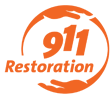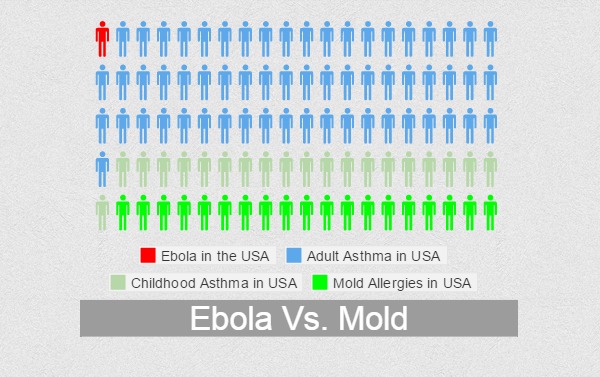Ebola. The deadly virus that can kill up to 90% of the people that contract it has ravaged West Africa for decades. In the latest outbreak, Ebola has killed almost 5,000 people in West Africa and appears to be almost unstoppable. Ebola has now come to the United States and the entire country is terrified. The mere mention of Ebola on a bus in Los Angeles provokes a terror and fear not seen since the dark days of the Black Death. But there is something much worse hiding in homes across America. It hides in the shadows of your basement, it can fester underneath the tile flooring of your bathroom, and it can grow in between your walls where you will never see it. And this thing can make you and your family extremely ill.
Worried about Ebola? You should worry about something far worse: Mold.
Just the Facts About: Mold Vs. Ebola
Since the latest Ebola outbreak there have been five known cases of the disease in the United States. Five. Yet everyone in the United States lives in absolute terror of contracting the Ebola virus. Statistically you are in greater danger of dying in a car wreck or dying of heart disease. You are also far more likely to become seriously ill from mold exposure. Let’s look at the facts:
- 60 Million Americans have some type of allergy, according to the Asthma and Allergy Foundation of America.
- 10% of Americans, or 6 million people, suffer from mold allergies, according to the American College of Occupational and Environmental Medicine.
- 7 million adults and 6.8 million children have asthma, according to the CDC, and inhaled mold spores often triggers asthma attacks, according to the EPA.
- 83 people died from hypersensitivity pneumonitis in 2010, according to the CDC. One of the causes of hypersensitivity pneumonitis is the inhalation of mold spores.
If you care about your health and the health of your family stop worrying about the Ebola virus, and start worrying about mold in your home.
The Types of Mold
There are over 400,000 known types of mold in the world and 1,000 of those types can grow in your home. Most of these mold species are harmless to your health but there are four main types of mold that your average homeowner needs to be concerned about:
- Cladosporium – This is the most common type of mold because it grows easily in moist, humid conditions. This type of household mold can appear green, brown, or black. Cladosporium is not technically toxic; however, it can cause upper respiratory problems, trigger allergy attacks and cause a more severe reaction in people with conditions such as asthma.
- Alternaria – This form of mold resembles hair like strands and is most frequently found on walls and floors. Alternaria frequently causes asthma –like symptoms, even in people who do not have asthma. It can also lead to further health problems down the road if left untreated.
- Aspergillus – This mold species is extremely dangerous because it can cause certain types of cancer. Aspergillus produces airborne carcinogens, which can be inhaled by you or your family.
- Stachybotrys – This is otherwise known as black mold, or toxic black mold. While it is less common than other forms of household mold it can be lethal. Stachybotrys has been linked to pulmonary hemorrhage in infants and can pose a host of health threats to adults. Homes that have recently suffered a sewage backup are particularly susceptible to the fast growing Stachybotrys spore.
Got Mold? Signs and Symptoms
What makes mold so incredibly dangerous is that oftentimes there are no related symptoms. Mold can grow in silence for weeks, months, or even years before it is ever detected. For instance, a homeowner discovers that a pipe under his sink has burst in the middle of the night and flooded his kitchen. He repairs the damage he can see but ignores the gray water that has wicked into the walls behind his kitchen cabinet. This provides an ideal place for mold to grow. And the mold grows, and grows, and grows …
There some signs and symptoms of mold exposure you should watch for:
- Sudden upper respiratory problems like coughing, sneezing, wheezing or frequent sinus infections
- Children with sudden mold allergies
- Asthma-like attacks in family members who do not have asthma
- Frequent, uncontrolled asthma attacks
- Diagnosis of a disease, like hypersensitivity pneumonitis, that is caused by mold
- Unexplained respiratory ailments
If you have experienced any of these symptoms you should call a mold remediation specialist to have your home tested for mold. 911 Restoration has over a strong reputation in mold removal and mold remediation. We are insured and licensed restoration experts. Call today for a free inspection.



